
The hut keepers
No country has anything quite like New Zealand’s network of backcountry huts, but many of these shelters were at risk of being lost to dilapidation, old age and the ravages of the weather. Now, volunteers around the country are preserving remote huts—and the heritage they represent—for the next generation of trampers.
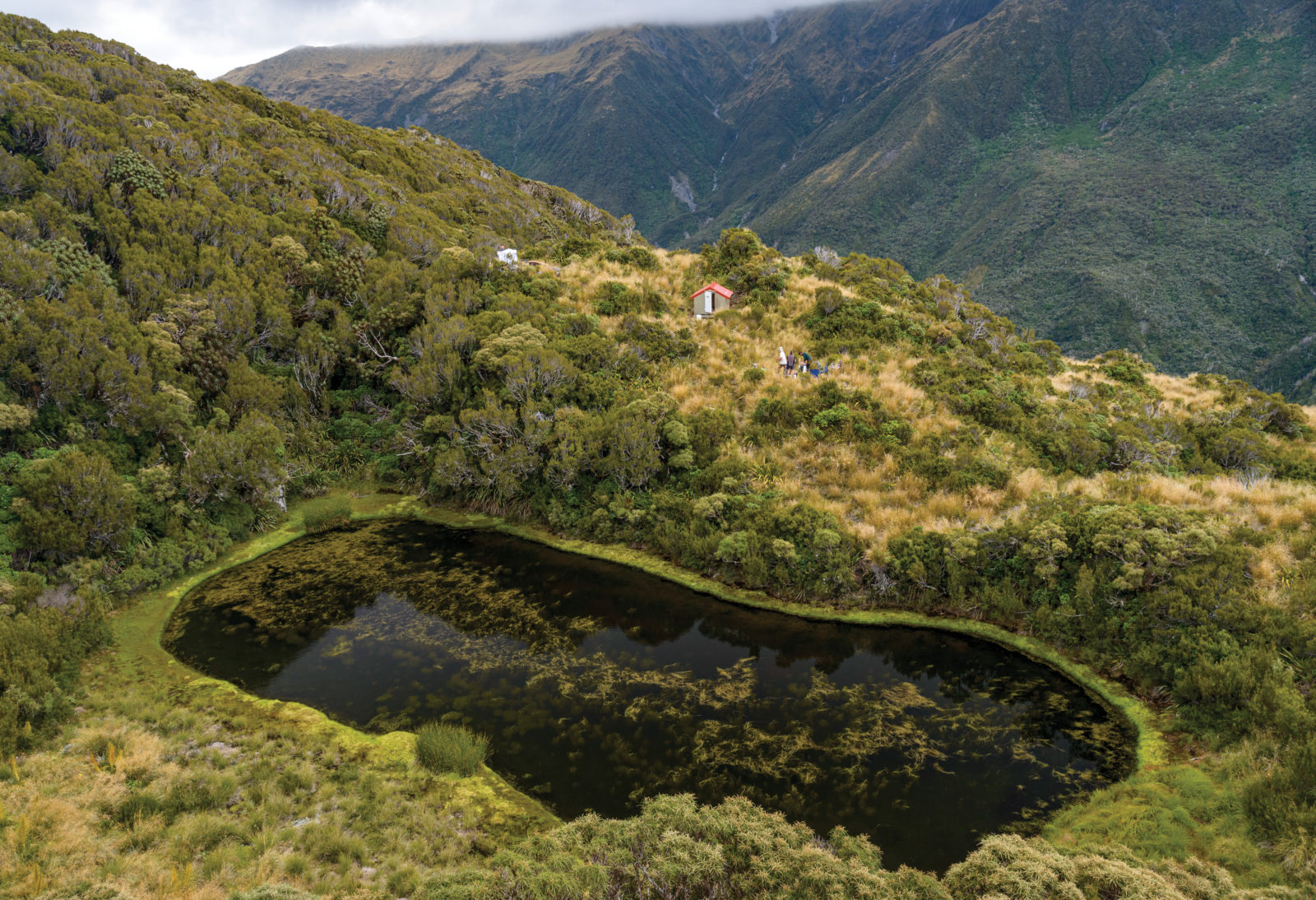
The moment after a helicopter leaves the backcountry is one to savour. You watch it dwindle to dragonfly size, hear the thump of the rotors fade, and then it is gone, and silence floods back like a river.
There were five of us standing on a knoll beside a sling-load of building materials and a fadge, an oversized wool bale, filled with tools and food. A few metres away was Crystal Biv, a two-person shelter, smaller than a hut, bigger than a tent (just).
To a hut nut, it’s an NZFS B55 model, built by the New Zealand Forest Service for its deer cullers in 1964. These are basic, no-frills structures, with no fireplace and no bunks (though some have sleeping platforms), originally designed as storage depots for food and ammunition. They’re called ‘crawl-ins’, to distinguish them from their slightly taller siblings, ‘stand-ups’, of which there are hundreds. You don’t actually have to crawl, but you do have to stoop to get in the door, and a person of average height can’t stand up inside.
Crystal had issues. The roof was leaking, and the window frame was letting water inside, where it had rotted out part of the floor. The building wasn’t even connected to its foundation piles on one side. A decent wind could have blown it off. Some of the rafters needed replacing, and likewise the exterior cladding. The whole thing needed bracing.

We had three days before a front was forecast to bring heavy rain.
Fifteen years ago, a party like ours, mostly volunteers, would not have been doing this work. No one would have been doing this work. Deteriorating huts were on a path to abandonment.
Three people who helped avert that fate—for Crystal Biv, and many others—were with me that February morning in the Toaroha Range. Andrew Buglass, Rob Brown and Ted Brennan each helped build the community movement that is rescuing at-risk huts from oblivion.
[Chapter Break]
New Zealand’s backcountry huts are a glorious melange of structures built over more than a century and probably unmatched in diversity anywhere in the world. There are former shepherds’ huts, rabbiters’ huts, roadmen’s huts, water-racemen’s huts, boundary keepers’ huts and, by far the greatest proportion, deer cullers’ huts.
When the Department of Conservation was formed in 1987, it inherited this eclectic inventory from the former Forest Service and the Department of Lands and Survey. With that inheritance came a hefty price tag: DOC had the backcountry assets but not the budget to repair and maintain them.
Over the next 20 years, huts and tracks in the remote zone slowly declined. Andrew Buglass (the first syllable rhymes with “bugle”) felt the loss keenly.
“I started to explore the West Coast high country as a teenager in the 1970s, at the end of the deer-culling era,” he tells me. “The advent of helicopter hunting had made ground-based operations obsolete. The cullers pulled out and left cupboards full of food. I could have had a self-saucing spongy pud every night. We feasted and explored to our heart’s content. And the huts were immaculate.”
By the 1990s, the network was becoming seriously degraded. Tracks were overgrown or washed out, and huts were becoming derelict. People didn’t use run-down huts as much, which meant the huts were maintained less often, which sped up the rate of decay.

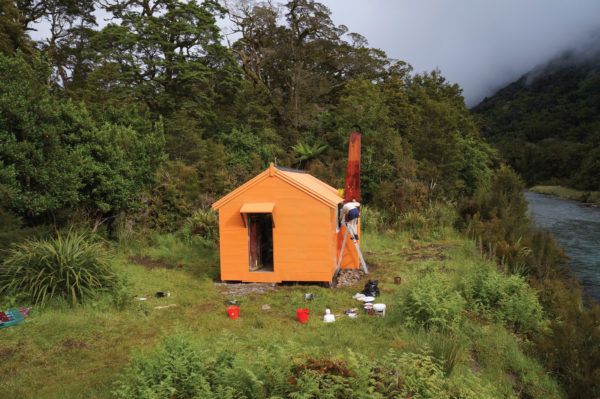
When a little-used hut reached the condition Crystal Biv was in, it was placed on a watch list for removal. Maintenance was minimal while the clock ran down. When it was deemed terminally unsafe, it was replaced with a new hut, or removed. Its existence—sometimes along with the tracks and bridges that led to it—was erased from official maps and destined to disappear from memory.
“When DOC started removing huts, I thought, ‘This isn’t good’,” says Buglass.
The Forest Service had placed its huts strategically so that each deer culler would be only two to three hours’ walk from another. It was sensible both in terms of distributing the culling effort and in case of emergency. But the way things were going, the hut network would cease to be a network, and Buglass was loath to let that happen.
“These places are my gym, my church, my therapy room, my bach,” he says. “They keep me healthy, happy and sane.”
One or two people had begun to adopt a hut and maintain it themselves, but Buglass wanted them all preserved. So, in 2003, he created a website, Remote Huts, to draw attention to them.
“Huts are eye candy,” says Buglass. “I thought if I showed photographs of them on a website and described the routes to get there, it would get people’s attention.”
It got mine. A few years after he started Remote Huts, I emailed him and said the site was intoxicating to those of us who dream of the hills but are more often than not stuck in town.
“Drool and chafe by all means,” he replied. “The website was cruelly designed to elicit cravings of that sort.”
The Remote Huts website features 67 West Coast huts and bivs (short for ‘bivouacs’) between Karamea and Haast, and today, a group of volunteers help maintain around 45 of those, along with their connecting tracks and routes.

Buglass called the volunteer group Permolat, after a brand of painted aluminium used for making Venetian blind slats. Forest Service cullers discovered that short strips of Permolat nailed to tree trunks made excellent, weather-resistant track markers. Although the use of Permolat has now been superseded by orange plastic triangles, some trampers prefer it, or at least regret its demise. Permolat markers reflect a tramper’s torch beam at night, like little squares of moonlight. The plastic markers don’t—they show up as grey.
Permolat is no longer sold commercially, but it’s still around. Buglass has been given rolls of the stuff by former Forest Service workers who had it stashed in their garages. He always carries some with him, and gave me a piece as a memento. If you flick it with a fingernail it makes a pleasant ping. One tramper told me that on a windy day, the sound of bits of Permolat rattling against their nails was like music in the forest.
Practical, humble, inexpensive, Permolat suits the ethos of the volunteer group, which now has 300 members. Its focus is Westland, which has the highest density of huts in the country, but similar groups have now sprung up in Southland, Canterbury and in the lower North Island.
In less than 20 years, the fortunes of the remote zone have seen a remarkable turnaround. Bivs designated for removal have been saved, low-use tracks maintained, and old tracks reopened. Permolat’s vision is spreading, and DOC has embraced the volunteer force.
“The department has realised it can’t do everything on its own. It has to partner with other groups,” says Ted Brennan, who is part of DOC’s planning team in Hokitika, and has been with the department since the beginning. He was five years old when he stayed overnight in his first hut, and has been in and out of them ever since. For a while, he was responsible for all the huts and tracks in central Westland.

In 2014, a consortium was formed from Federated Mountain Clubs (representing trampers), the New Zealand Deerstalkers’ Association (representing hunters) and Trail Fund NZ (representing mountain bikers) in partnership with DOC to provide a nationwide pool of funds for the work of Permolat and similar volunteer groups. The consortium is now called the Backcountry Trust, and in the past five years, it has funded the restoration by volunteers of more than 150 huts. (DOC is the most significant financial backer, providing the Trust with $350,000 per year, soon to be $450,000.) The volunteer work reflects a shift in attitudes: from an expectation that this work is DOC’s responsibility, to a feeling among people that these places are theirs to maintain.
As Rob Brown, Backcountry Trust grants manager, put it, “The mindset now is: ‘These are not DOC’s places, they’re our places. And we’re going to look after our place’.”
[Chapter Break]
The summer days were long, and the work filled the hours from daybreak till dusk. The sun lit up one set of mountains in the morning, then blazed another in the evening. One morning, we saw kea perching in treetops on a ridge. At night, we slept to the croaking of an amphibian choir in the tarn below.
Buglass, who declared that carpentry had been his worst subject at school, headed away early with his partner, Joke (“yo-kuh”) de Rijke, to cut back the vegetation that is forever closing in on a track. Keeping tracks open is as vital as keeping huts operational. Buglass always takes loppers and a fold-up pruning saw with him on his trips into the hills, and encourages other Permolat members to do the same. De Rijke, a Christchurch acupuncturist and masseuse, has worked on more than 30 hut and track projects with Buglass in the past decade. Originally from the Netherlands, she tells me that being involved in restoration and track work “took my tramping to a different level”.
The rest of us worked on the biv. We removed the roof and the old chicken wire and tarpaper from the walls, along with most of the iron cladding, and put in new rafters and studs. The whole back wall had to be rebuilt, and a rotten section of floor replaced with matching recycled tongue-and-groove rimu.
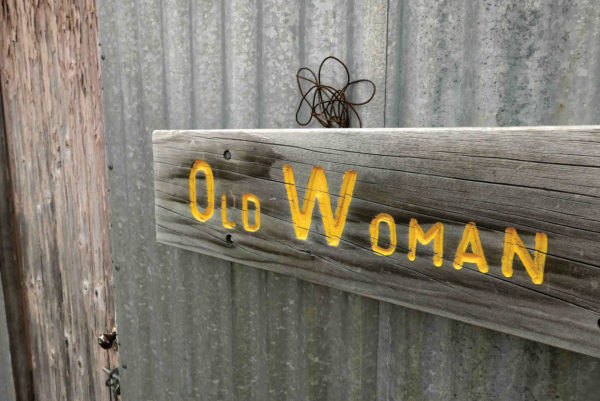

Reconstructing the floor felt especially good to me—a jigsaw puzzle of carpentry that used the materials of the original biv.
Another part of the restoration felt less authentic. The old louvre window, its frame rotten and leaking because it hadn’t been flashed properly, was replaced with an off-the-shelf double-glazed aluminium window.
That window became the focus of debate: How to retain a hut’s historical character while future-proofing it against the rigours of the environment?
Brown, who was leading the restoration work, wrestles regularly with the dilemma of heritage versus utility. On the matter of the window, he told me he had, in fact, looked on TradeMe for wooden-framed louvres, but not found one. Then again, there’s a lot to be said for a draught-free, warmth-retaining, aluminium-framed modern window that will never rot. How does a
hut-restorer decide?
Brown has a couple of rules of thumb: ‘Like for like’, when you can get it, and ‘leave the hut in no worse state’—a sort of hut-keeper’s Hippocratic oath. Mostly, though, his priority is to reduce the amount of maintenance required.
“For years, there was a feeling in DOC and the wider community that the whole job was too big,” he says.
“There were too many huts, and we couldn’t look after them all. One of the most exciting things we’ve shown is that it’s a reasonably straightforward job, not requiring a whole lot of money, to look after the whole network.”
One principle that guides the Backcountry Trust when considering applications for hut work is scarcity value. How many of a particular type of hut remain in the network?
“We’re mindful of disappearing heritage,” Brown tells me. “I would say that of the hundreds of standard six-bunk Forest Service huts that were built, there’s probably only 20 unmodified ones left. Not many of them still have the food cupboard, the open fire, the original lining with its cowshed-green colour scheme.”
Another principle is that the group doing the work gets more of a say. A restoration team may propose to install solar-powered lighting—a modern luxury that reduces fire risk—or may prioritise the ambience of an open fireplace over a more efficient wood burner. For this reason, in a few huts, open fireplaces have been reinstated years after they were removed.
“We don’t want to go down the DOC path of becoming slaves to standards,” says Brown. “Minimum standards, yes, standardised, no.”

There’s robust discussion in the backcountry community over what heritage means, and how immutable it should be. Brown tells me about Derrick Field, a former Forest Service ranger who is a powerhouse for hut restoration in the lower North Island.
“I was looking at one of his proposals, for work on Carkeek Hut in the Tararuas, and saw that he was planning to keep the old wire-wove bunk bases. If you’ve ever spent a night in a hut with those wire-woves, [you’ll know] they squeak all night as people toss and turn, and no one gets any sleep. I emailed Derrick and said, ‘Why not put a bit more into the budget and build some proper bunks?’ He replied with one line: ‘History, Rob’.”
Heritage can seem like an abstraction when the floor is rotten, the window is leaking and the roof is about to cave in. But I wondered at what point, on the restoration continuum, a cherished building loses its identity to a person who is familiar with it.
I was thinking of an entry in the Crystal Biv hut book I had noticed when we first arrived. Among the usual comments one expects—“Plenty of chamois seen”, “Frog song very impressive”—one on the last page caught my eye. It had been written a few weeks earlier, and was a note directed to us, the restoration crew. It was a plea not to turn the place into “a generic DOC box”. The writer referred to the biv as her “Crystal Palace”. The message was signed, “Emma Richardson”.
[Chapter Break]
On the last morning, when it seemed we would complete the work before the weather closed in, de Rijke urged me to take an hour to climb to a ridge that had been beckoning ever since we arrived. It’s part of the ‘tops route’ to nearby Yeats Ridge Hut that trampers follow if they prefer tussock and rock to the river and forest of the valley track.
‘Tops’—what adventure is conjured in that little word. The understatement of it, like so many of the other words we use for the outdoors: ‘hills’ for snow-capped mountains, ‘bush’ for old-growth forest, ‘fresh’ for a river that is running high.
She and Buglass had cleared the route the day we arrived, but it still took concentration to find it, or in some sections of chest-high snowgrass, to choose a line and follow it doggedly. I stopped at a moss-fringed tarn and lay in it for a while, then climbed to the top of the ridge for the view of mountains on mountains receding and the yearning to follow where they led. In such a place one might say, in the words of writer Wendell Berry, “I am reduced to my irreducible self…I move in the landscape as one of its details.”
A pipit on a rocky outcrop trilled and flicked its tail as I turned to make my way back to the hut, moving in the landscape as one of
its details.
The clock was ticking. The weather was coming in. We dealt with the final jobs: sealing the edges of the new iron cladding, getting a couple of coats of paint on, lining the interior walls with plywood. Brown screwed the nameplate back onto the newly painted door. Crystal Biv looked brand new.
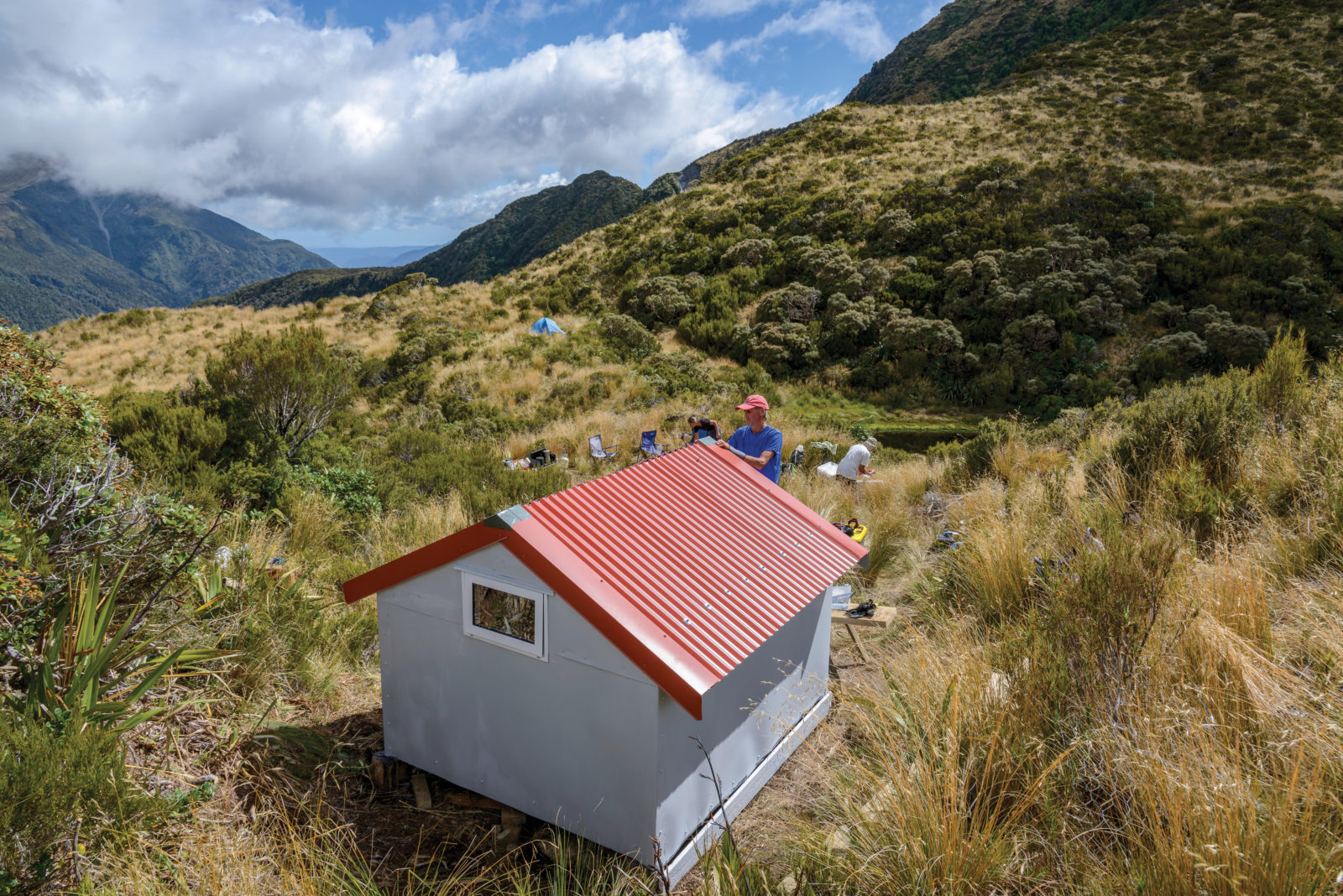
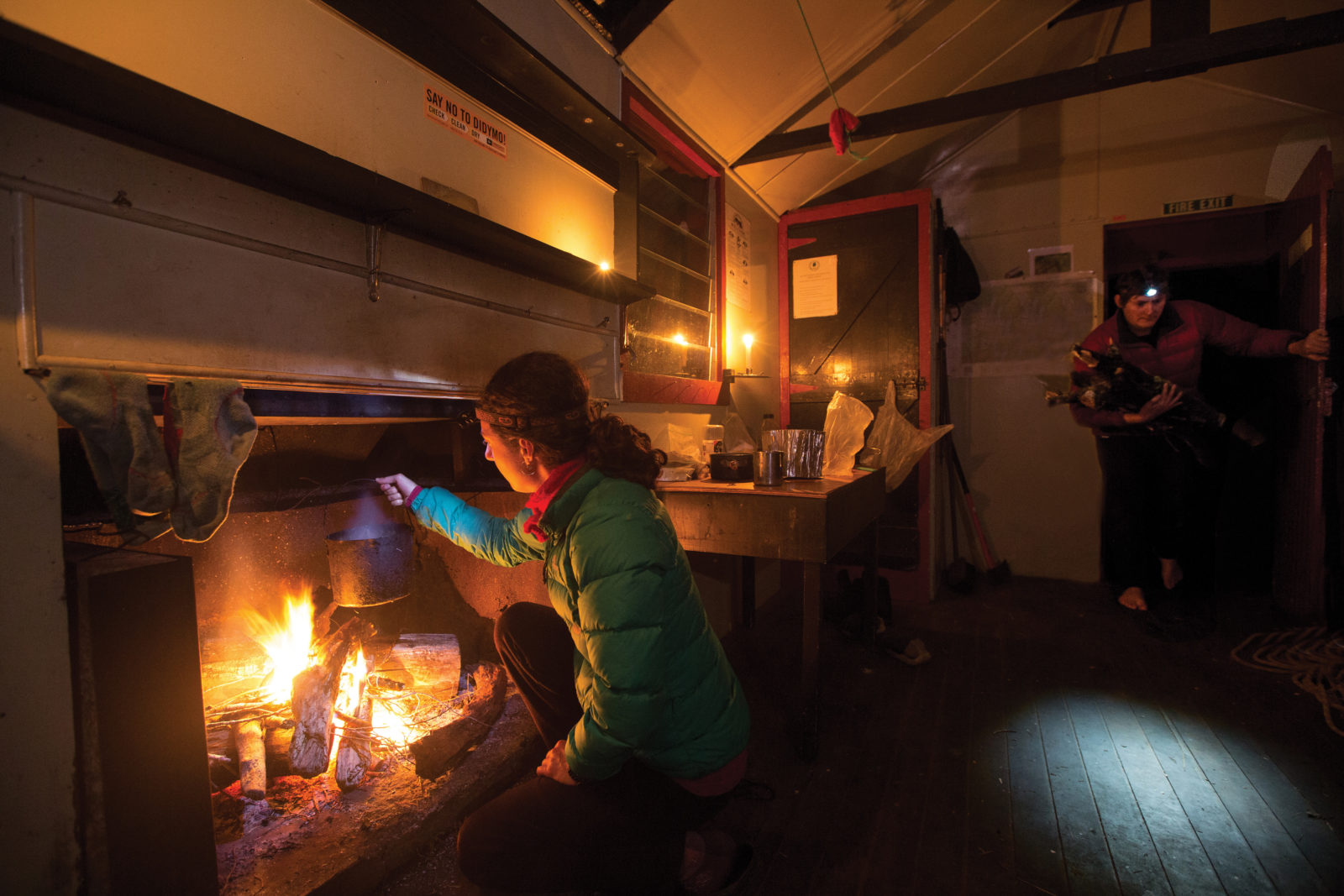
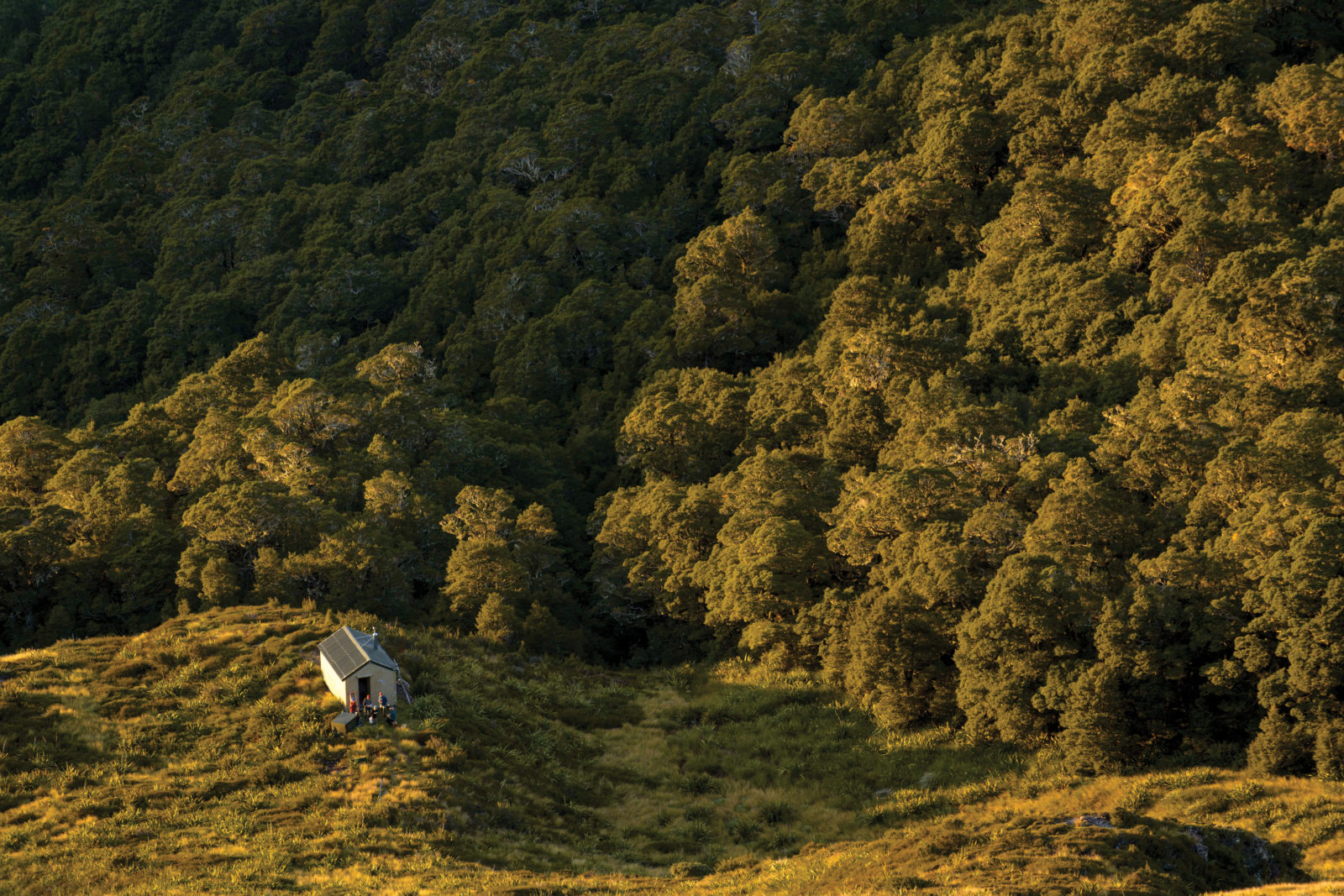
I thought about what was written in the hut book. What would Emma Richardson make of the makeover? Had we turned her beloved bolthole into a generic DOC box?
It wasn’t long before that question was answered in a way none of us could have predicted. The following week, Richardson walked in and saw red—and not just the colour of the new roof. To her eyes, the removal of the sleeping platform and the addition of varnished plywood to the walls had destroyed the character of the place. Her palace of simplicity was now a soulless cubicle. It was a betrayal of the place she loved.
Betrayal turned to anger. She wrenched the plywood off the walls and sawed it into planks to reinstate the sleeping platform, and left a blistering message in the hut book.
I was left feeling uneasy—and a little miffed. I had installed most of that plywood. She had undone my work.
Some weeks later, I visited her at Kumara to ask her about what had happened. Part of her reaction, she tells me, had to do with the extent of the renovation.
“It was heartbreaking walking in there. In terms of what was done, I really resented the plywood. Places like Crystal were only ever meant as emergency shelters, or at a pinch a night or two for a culler. You go there expecting it to be rugged, small, simple. You lie in there on your one-person sleeping platform, and that’s the joy of it. Now the charm and the character have gone. It’s like any other plywood generic hut.”
There needs to be limits on the impulse to endlessly improve and upgrade huts, tracks and amenities, she says.
“Keeping the huts basic means that only the people who are really interested will go there. People who come from overseas recognise the value of that simplicity. I don’t think they expect all kinds of bells and whistles. Simplicity is getting rarer all the time. It’s something that’s on the way out.”
Since Richardson’s visit—her intervention—DOC has reinstated the plywood lining. Other volunteers installed a stainless-steel bench, brought in a couple of new mattresses and replaced some of the piles.
“On one level I can see where Emma’s coming from,” says Brown. “It will feel like a new hut. She’s not going to lie there at night and have all the familiar tatty building paper and chicken wire. There’s an ambience about that you’ve got to acknowledge. But I’m in no doubt that if you go back to that hut in 10 years, it will have developed its own character. People will bang nails in, signs will appear, someone will add a bookshelf.
“My main regret was not explaining the reasons for the plywood—that structurally we had to do something to brace the building. There’s a reason we put 12 millimetre structural ply in there. We weren’t putting it in for cosmetic reasons. Those bivs have a wobbly, lightweight, 50 by 50 millimetre frame. You would never build anything like that in the alpine zone today without bracing it.”
Some huts were nearly lost, he points out, because of a lack of planning around how to pass them on to the next generation
[sidebar-1]
“These places aren’t the same now as when I started tramping, and they’re not going to be the same for my kids,” he says. “I have such powerful memories of arriving at Maungahuka Hut in the Tararuas in a storm. That old Forest Service hut is gone now, replaced by a new DOC hut. But today’s and tomorrow’s trampers, arriving at that new hut in a storm, will make their own attachments and forge their own memories.”
And yet, there is a moment at Crystal Biv that stays with me, provoking a pang of conscience. The hut was being swept out, and I was bagging the rubbish. A rusty tin half-full of melted candle wax was tossed into the pile of dust and shavings. I picked it up.
“Should we keep this?” I asked. “No, toss it,” came the reply. So I tossed. At the time, it seemed of no importance. But later, it seemed to me that where one person might have seen melted wax, another might have seen 20 years of light.
When I tell this story to architectural writer, academic, activist and lifelong tramper Tony Watkins, he says that for him, the wax in the tin represents continuity, “and continuity is another word for heritage”. If we want to preserve heritage, he says, we have to be thinking about ways to preserve continuity between people within and across generations. The baches on Rangitoto Island are one example.
“A bach is a social process. It begins with love of the place. The baches on Rangitoto were about a way of life. Sharing lunch with other bach dwellers. Sharing a fish. Borrowing a corkscrew. The building was incidental. In the same way, I think the critical thing about tramping huts is: first you tramp. Unless you tramp, how can you understand a hut? You have to be wet and cold and desperate to understand a hut.
“A hut isn’t an object, it’s a physical manifestation of a way of being, a way of life, a measure of love, and its form comes out of those things. So when you go into an SF70 Forest Service hut as a tramper, you know exactly what you’ll get. What you are entering is the world for which SF70s were designed—deer cullers and Forest Service rangers.”
I entered that world when I visited a 120-year-old musterers’ hut set back in a notch between bluffs on former Quailburn Station, now part of Ahuriri Conservation Park, near Omarama.
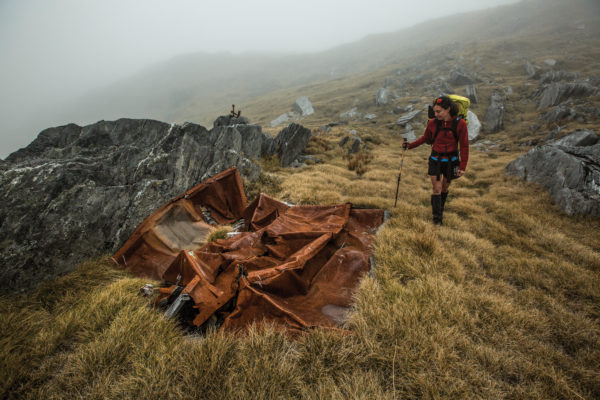
On the roof and walls of Hideaway Hut, hundreds of names are inscribed on the corrugated iron, making of this place a museum and an archive. Shearers, musterers, rabbiters—even former Governor-General Lord Bledisloe—signed the hut, as if it were a three-dimensional hut book.
Apparently, the graphite in pencil lead reacts with the zinc coating of corrugated iron to permanently etch the surface. Names and shearing tallies written in the 1890s, when the hut was built, are clearly visible today—though some, including Bledisloe’s, are slowly being obscured by encroaching rust.
The interior of the hut was restored in 2005 by former DOC ranger Clint O’Brien, using period materials: beech-pole framing and a clay-cement mix for the floor. The restorers built a rough table and stools from timber slabs, and the bunks are made from beech poles, too. A rusty corned-beef tin, a candle in a coil of wire, a deck of cards, several of them hand-drawn, lay near the window. I looked through that window a long time at the chalky scree hills, cloud shadows moving across them like sheepdogs. It was the view that every rabbiter and musterer saw, little changed in a century.
[Chapter Break]
To be sure, not everyone is looking for an historical encounter when they arrive at a hut after a freezing struggle through sleet and mud. Sometimes, trampers choose huts with modern conveniences: solar lighting, gas cooktops, drying rooms, sun decks, insulation, no rodents scampering along the rafters at night. Nor does every hut need to be a time capsule—though these are the ones I find the most enriching, those with tendrils of connection that link me to this country’s past.
One evening, I hiked to Riordan’s Hut, on the Kill Devil Track in Golden Bay, starting at sunset from the road end near Takaka and finding my way for the last section by torchlight. It is one of several Golden Bay huts that have been restored under the expert eye of Max Polglaze, a long-retired Forest Service ranger who knew the old-school techniques of pit-sawing, adzing and splitting roof shingles with a broad axe.
The mustering hut was built in 1926 by two brothers named Riordan. In the Depression, it served as a storage depot for 40 unemployed men who dug for gold in the surrounding hills. A folder in the hut has a typewritten interview with one of the brothers, Laurie Riordan, recalling his days as a packer, carting meat and groceries to the prospectors. Mutton forequarters, two and threepence.

Riordan spoke of “how pitiful it was to see some of those unemployed men living way in there. I wondered why the authorities ever let them go in, let alone pushed them in. Chemists and clerks, some of them wouldn’t have known a nugget of gold if they picked
one up.”
By the early 2000s, the hut was on its last piles and scheduled for replacement. For John Taylor, another former Forest Service man, a new hut in an area so full of history seemed wrong. The thought of losing 75 years of heritage weighed on his mind. It would insult the memory of those hard-scrabble diggers. He asked Polglaze if he would take a look.
Polglaze spent five days of “most excellent quiet time” at the hut, “listening for the still, small voice”, he wrote in his diary, recorded in Shelter from the Storm: The Story of New Zealand’s Backcountry Huts. “Rebuilt the disintegrating door one day—would dearly love to restore the whole hut.”
And so he did. Over a two-month period in 2003, using old tools and old ways, he and Taylor milled cladding from dead spars and windfalls from around the hut, split roofing shingles, and used beaten-out tar drums to make a new chimney.
A replacement hut would have cost $80,000. The renovation cost $12,000. The value? Incalculable.
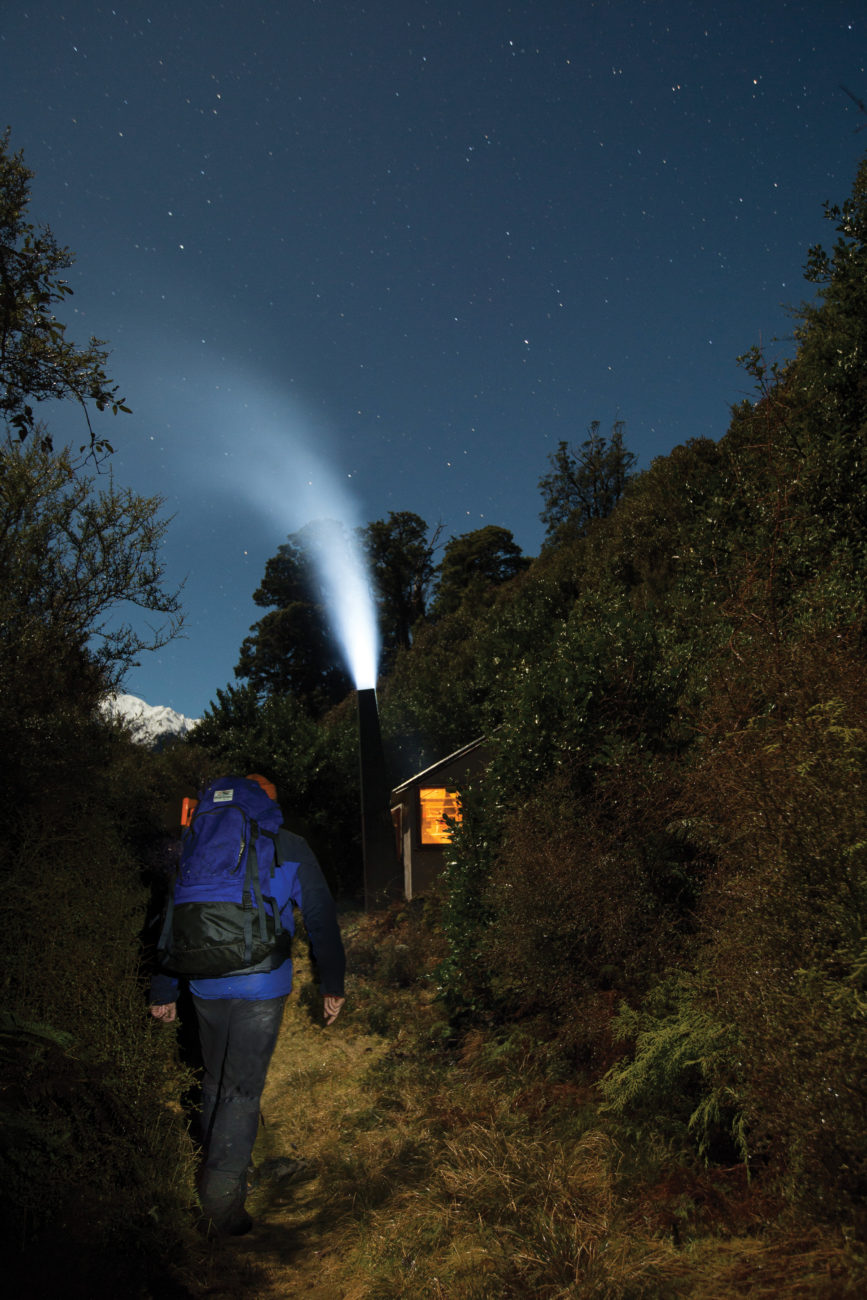
Permolat and the hut-restoration movement have tapped the enthusiasm and skill sof a wide range of people around the country: retired rangers who never had the budgets for the maintenance work they wanted to do, hunters with day jobs as builders who donate their skills to backcountry restoration, keen outdoorspeople who carry out the grunt work of sanding and painting.
The fact that few trampers may find their way to a remote spot such as Crystal Biv for a night isn’t a deterrent to spending time or money on restoration—for Andrew Buglass, the entire point is to retain places where quiet may be found, and where still, small voices may be heard.
“This is a zone of simple shelters and rough, unformed tracks and is the preferred abode of the remote hutter,” he writes on Remote Huts. “A parallel universe in which there is great beauty and the opportunity still to experience true wilderness solitude.”
One night, talking to Buglass before unrolling my sleeping bag on the bunk in his backyard biv—a derelict mountain hut he rescued from the Hokitika tip after DOC had removed it from its perch on Whitehorn Spur—he says that, for him, entering a backcountry hut is a “liminal experience”, stepping over a threshold.
“It’s hard work to get to a hut. Hours of slog. That moment when you push open the hut door and step inside is like crossing a divide. You light the fire, put the billy on, open the food cupboard, and a transformation happens. You’ve left the city consciousness behind, and suddenly you’re conscious of the river roaring, the wind howling, maybe a distant avalanche.”
The hut-restoration movement is leading to a changed relationship to these remote places. People want to be involved. People need to be involved—it’s how we maintain a relationship with our heritage. Yes, DOC could do it for us, but that’s no longer the point. Involvement generates connectedness. Connectedness generates wellbeing.
When these humble buildings are restored, their stories are revived. And we, who seek shelter, companionship and repose within them, find that they are not just a roof and four walls, but so much more.

















